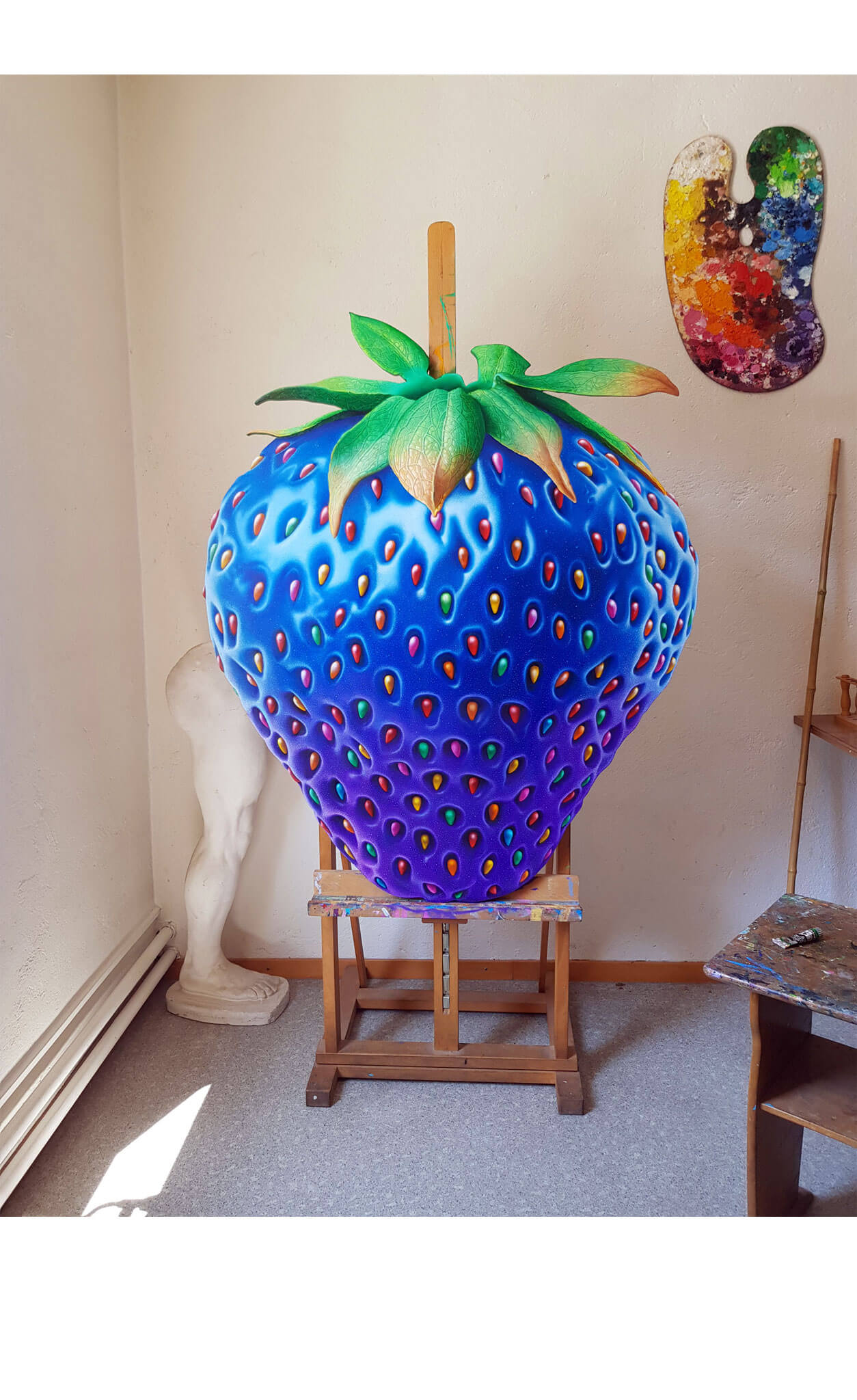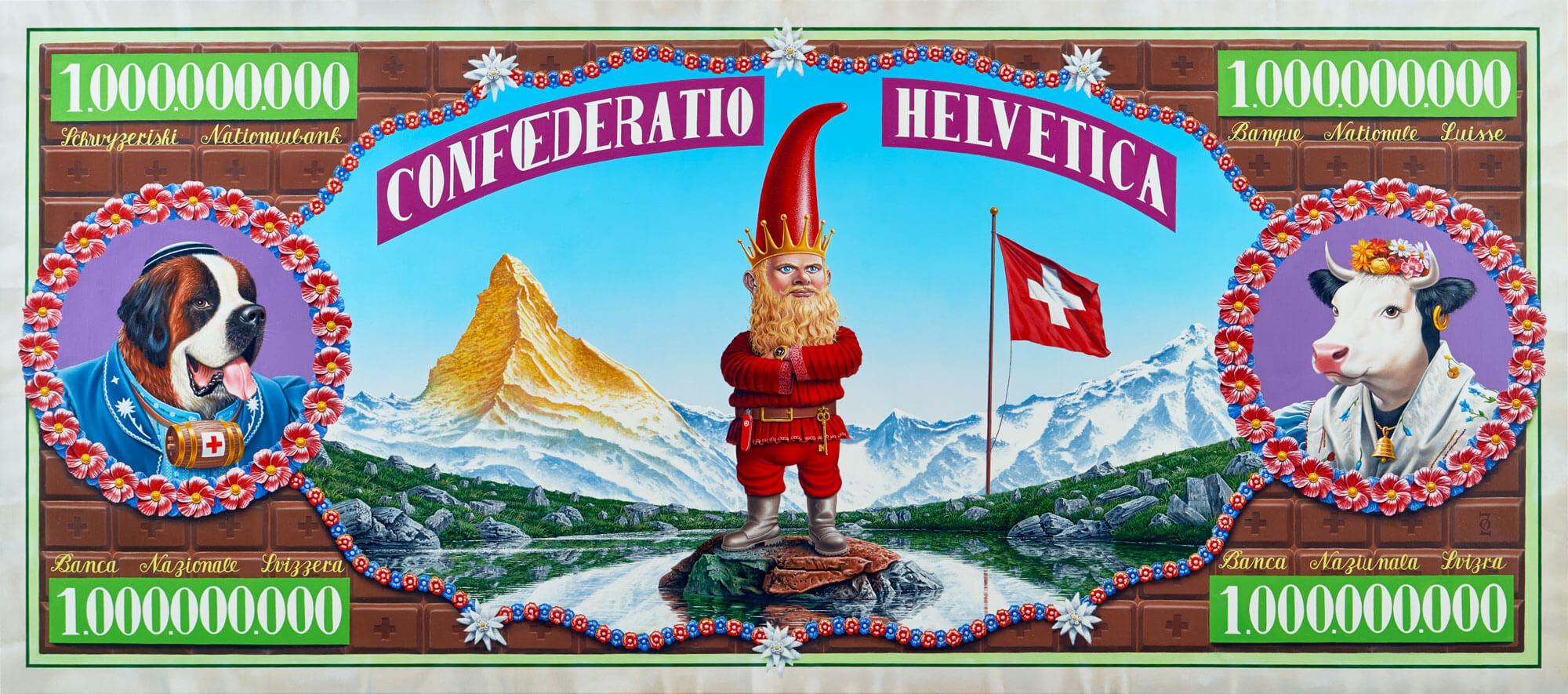Pop Art
Swiss Chocolate
Oil on canvas — 84x200cm — 2021
Swiss chocolate with multiple harmonic symbolism: Diversity of colours in the unity of form. Diversity of flavours in the unity of cocoa. Diversity of cantons in the unity of the constitution. Diversity of origins, races, identities and languages in the unity of nationality. Diversity of power in the unity of decision. Diversity of opinion in the unity of consensus. Diversity of faiths in the unity of the cross.
Edible Flower
Oil on board — 122cm — 2017
A green salad awakens our appetite. But a multicoloured salad confuses our perception, cuts off our appetite and makes us see another reality. The semantic relationship between the object and its natural colour makes us recognize it. This recognition is disturbed when the natural colour is changed.
Organic Strawberry
Oil on wood — 120x120cm — 2019
The strawberry symbolizes our relationship to food. We have moved away from nature to build a sterile and artificial world. Our mind has moved away from our own nature to build a sterile and artificial world of thoughts. Our conception of what is natural is based on our artificial view of life. This is why a strawberry today, however organic it may be, is artificial compared to its ancestor the wild strawberry.
Healthy Food
Oil on wood — 122x125cm — 2019
Man has been manipulating nature for centuries, and today’s food, no matter how organic, is already transformed from its original state. Yet it seems natural to us. In this logic, tomorrow’s food, ever more artificial, will appear natural to its contemporaries. And we will not hesitate to eat a blue hamburger as we find it appetizing.
Nirvana Hamburger
Oil on wood — 200x100cm — 2019
Living in the wild, we found it difficult to find our food by hunting and farming. It was scarce, but natural. Living in an artificial world, we could easily find our food by buying it. It is abundant, but artificial. Abundance and its corollary artificiality are the alpha and the omega of our modern relationship to food.
Good Soup & Tasty Sandwich
Oil on board — 123cm — 2017 | Oil on board — 52x184cm — 2014
Through sexuality, fashion or advertising, the woman’s body is used, consumed and then thrown into oblivion. Barbie’s eternal smile represents a form of unconscious assent that participates in this exploitation.
Fridge Door
Oil on canvas — 81x54cm — 2012
A fridge door is something that we open twenty times a day without looking at it, busy as we are contemplating the inside of the fridge. At first glance, the surrealist irruption of incongruous elements does not change the appearance of this door, but transforms a banal and functional object into a world of fantasy and mystery.
Bang!
Oil on canvas — 184x184cm — 2014
The surprise gift possesses high centrifugal and centripetal force at a high degree of intensity.At first, its visible container is so dazzlingly beautiful that it makes us forget its contents. In a second time, its invisible content is so mysterious that it makes us forget its container, which is torn and thrown into oblivion, even though its content could be disappointing compared to its container.
Made in China
Oil on canvas — 100cm — 2011
Made in China represents the China of dragons, mandarins and the Forbidden City, converted into mass industrial power. The Chinese dragon, dead, in a can, reproduced in billions of copies, is the fallen memory of ancient China in modern China.
Unidentifiable Object
Oil on canvas — 100cm — 2013
A non-identifiable object should not be confused with an unidentified object. In the first case, it is impossible to define the object, in the other it is the opposite. A nipple, or a button, or a pig, or a balloon, or all of these at once, make an non-identifiable object. It is not a question of asking what the object is in reality, but of accepting the reality of the object without asking what it is.
Confœderatio Helvetica
Oil on canvas — 100x230cm — 2015
A country issuing a billion bill is a ruined country. When its development comes to a halt, it withdraws into itself, reverting by force of circumstance to its fundamentals and its natural resources, if any. The dwarf represents the Swiss. He lives on a heap of gold and cuts precious stones. He jealously guards his treasures and the key to his safe never leaves him. He does not like to be disturbed and lets it be known promptly. King on his mountain, he watches over his loneliness fiercely.
One Million Dollars Banknote
Oil on canvas — 100x230cm — 2010
If the United States of America were to issue a million dollar note, it would be the sign of their ruin. The American dream of freedom, prosperity and enjoyment is symbolised by the piggy bank in the middle of a party, in an abundance of food and streamers. The dream, like soap bubbles, always fades away eventually. And the desire for enjoyment remains alone, hungry and pointless, like a solitary denture, which is made to eat but cannot.
One Cent (“E Pluribus Unum”)
oil on board — 30cm — 2018
E pluribus unum is a motto that paradoxically applies to the United States of America. The people are filled by a strong patriotic sense of a unique identity that truly makes them: “One from many”. But individualism possesses this same people and irremediably divides it: individual against individual, individual against community, opinion against opinion, race against race, and reverses the motto: “Many from one”.
























